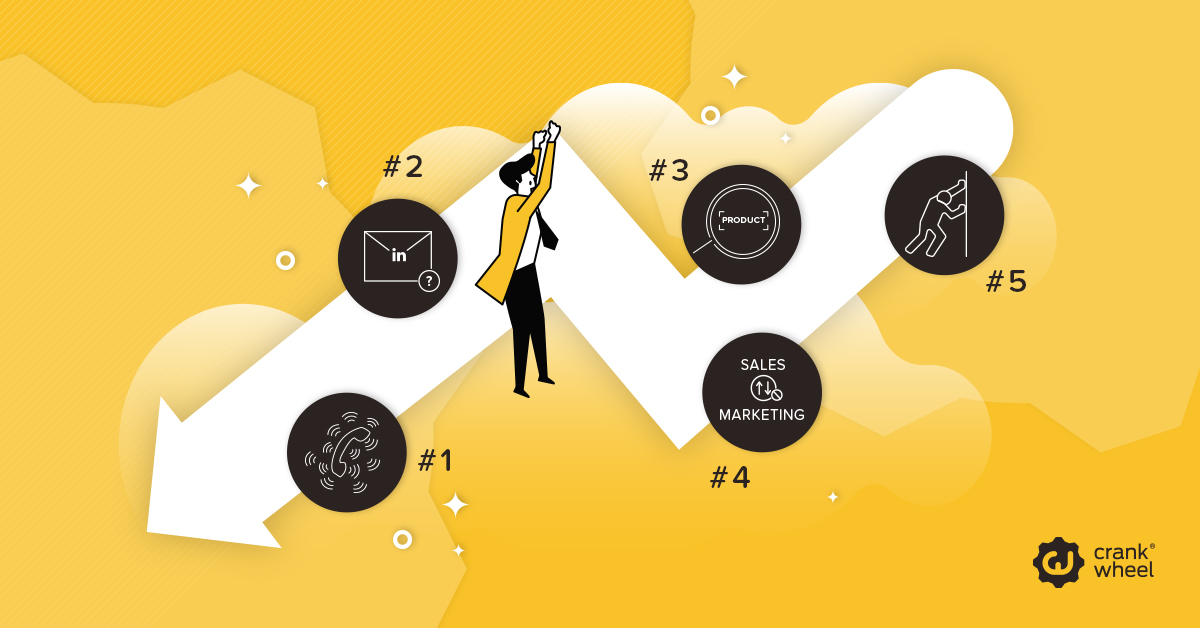Sales tactics we need to abandon in 2020
Some sales tactics need to be left behind. With 2020 fast approaching, the last year in the second decade of the twenty first century, we have put together a few that are worth forgetting about.

The good news is, as old tactics prove unhelpful in this hyper-connected era, there are plenty of new ones to try out. Even in a profession such as sales. Although the fundamentals of establishing and building relationships is the same as ever, the way we manage these, cultivate new ones, and keep prospects, clients, and managers informed and engaged is constantly evolving.
With that in mind, here are five tactics that need to be quietly dropped for everyone’s sales playbook.
#1: Cold, cold calling
Most salespeople have seen The Wolf of Wall Street.
It quickly became another DiCaprio classic. But does anyone in sales think they ought to be phoning hundreds of prospects all day every day, and does that tactic ever work? In B2B sales, even when relationships are transactional, there is a relationship that needs to be established first.
If your company’s lead generation is founded on calling a list of names, there might be a reason in 2019, and 2020, why this tactic isn’t working anymore. It is outdated. It takes longer these days to reach a decision maker.
And if you are calling decision makers and budget holders who are in their 20s or 30s, not many are happy to pick up the phone to a number they don’t recognise.
Cold calling without any other supporting marketing or sales activity, is one of those sales tactics that should be left firmly back in the 1990s, just like pink sheet stocks and drinking cocktails at lunch.
#2: Zero interaction LinkedIn cold messages
Just like cold calling, without anything else, such as marketing or email, should be left in the 1990s, LinkedIn messages sent 5 seconds after connecting should be left in the early 2000s.
When sales people connect with prospects, there is an expectation that some will reach out and attempt to sell something. That shouldn’t be discouraged. There are only so many ways to reach prospects and LinkedIn is an essential one for sales professionals.
But sending a message without any other kind of interaction rarely gets people anywhere. Instead, start commenting on the content your prospects are posting. If they ask a question, or ask for a recommendation, try and provide a useful answer. Give something before you give them a pitch.
And even then, when reaching out, don’t shove a sales pitch in their face. Ask them questions. Mention something they or the company the work for has published/done recently (e.g. a press mention), and then see if they are having a problem that you can solve.
Ask questions and interact on LinkedIn before cold pitching.
#3: Sales without Marketing
Sales and marketing are both revenue generating functions.
Sales is at the sharp end of things. Marketing plays the longer game. But they both, at the end of the day, contribute to a company’s growth.
Sales and marketing should have a positive, interconnected relationship. Providing your marketing team is generating leads, they should be sent through in real-time to avoid opportunities being lost. Time is everything when an inbound lead is interested in a new service provider.
At the same time, for those leads who aren’t quite ready yet, marketing should have automated systems in place to keep them interested. Such as an automated lead nurturing funnel; one that cycles them back into sales calls/emails after a certain number of weeks.
Marketing should also provide sufficient sales enablement support to ensure that sales teams can deliver online or in-person presentations without difficulty.
#4: Pushing too hard
Sales people who push too hard are at risk of losing a prospect.
Yes, you’ve got targets to hit. So does everyone, including, probably the person you are trying to convince to sign on the dotted line. But at the same time, forgetting that they’re looking for a solution that you can potentially provide, that is the best way to chase them away and into the arms of a waiting competitor.
So for those time-intensive deals, be prepared to wait. Keep them ticking over. Keep nurturing them. And whenever possible, ensure you’ve got enough transactional and quick turnaround ones in the pipeline to keep hitting target while working on the ones that need more finesse and time invested to get them over the finish line.
#5: Focusing too much on the product
Products and shiny, all singing, all dancing presentations don’t secure sales. Want to know what does?
A well thought out solution to the client’s problem. Consultative selling is all about working out what a client’s problem is and then providing a solution, based on your products and/or services, that meets those needs, and ideally does so in a timely fashion that ensures a sales team hits target.
Over-selling a product, or worse, claiming it does something it can’t, is one of the best ways to lose a sale. The same is true of giving discounts away too quickly.
Instead, make sure you’ve asked the right qualifying questions to provide a solution. Demo the solution, and if a prospect asks for a discount, we’ve got a few ways you can get around this tricky one. After that, follow-up like a pro until you get an answer.
